November 16, 2021
India’s Growth Story Towards $10 Trillion Economy

Sandeep Sahni
Co-founder & Partner, Sahayak Associates
India was one of the largest economies in the world from the end of the 1st millennium BC till the beginning of British rule in India. India was called the ‘Sone Ki Chidiya’ or the Golden bird as India used to command a 24% share of the World Economy. India’s share of global industrial output declined from 25% in 1750 to 2% in 1900 and its share of the world GDP was down to 2.7 % in 1947. Currently, India’s economy at $2.87 trillion accounts for a 4.7% share (PPP) of world GDP.
From a $ 14 Billion economy at Independence, it took us 60 years to achieve the $1 Trillion mark in 2007. The subsequent trillion, however, took less than 10 years and we are en route to achieve the $3 Trillion mark in 2022, i.e. in around 5 years from the last Trillion. In the 75th year of independence, India stands on the cusp of major change: a transformation that could lead to unprecedented economic growth paired with radical improvements in the nation’s Human Development Index (HDI).
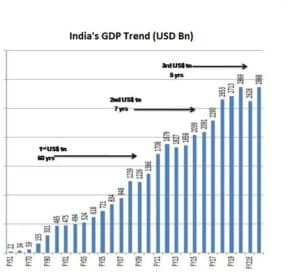
Though we have traveled a long way since Independence, we still have a long way to go.
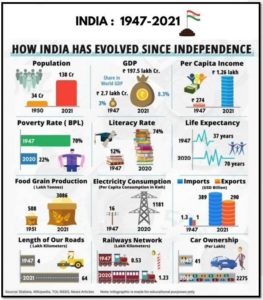
To achieve a $10 Trillion Economy in the next 10 years, India needs to grow at a nominal rate of around 12.5% which is achievable if we can grow our Real GDP @7-8% with an inflation of 4-5%. It is imperative to do this to offer opportunities to the burgeoning youth population and upgrade the standard of living of the vast populace still at the subsistence level. We need to create 10-12m jobs every year in the coming years to provide quality of life for our growing youth population and emerging middle class which will be a billion strong by 2034 with rising aspirations. A double-digit nominal GDP growth rate will ensure that the per capita income rises from the US $1,900to around the US $7,500 thereby boosting the quality of life for more than 1.25bn citizens.
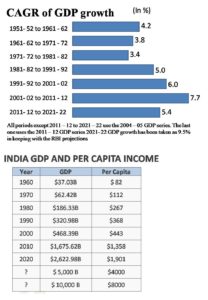
A famous investor once said, to identify a good investment idea, first find the story and then look for numbers.
The main pillars or contributors of economic growth are going to be :
a) Public and Private Sector Investment
The NIP (National Infrastructure Pipeline) is expected to attract major investments into infrastructure. Nearly 7,000 projects across different sectors costing above INR 100 Crore per project and totaling Rs 111 Lakh Crore have been identified. India is on the cusp of a longer-term earnings recovery cycle. Earnings growth for corporate India is expected to be around 25% in FY22/23 with a constant improvement in Corporate profit to GDP ratio.
The private sector investment is also getting a major boost aided by the PLI scheme, capacity addition due to high levels of capacity utilization, low-interest rates, and deleveraged corporate balance sheets.
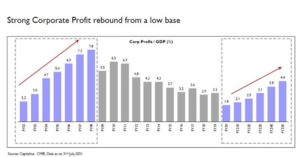
b) Consumption
Consumption is likely to get a further boost with rising in per capita income and the resultant increase in discretionary spending and low penetration levels of most consumer goods, especially in rural India.
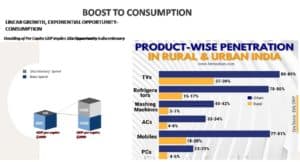
c) Exports
India has so far had a consumption-led growth wherein most developed countries had an export and investment, especially an Infra-led growth.
Exports, especially in IT, SAAS, Pharma, chemicals, services, etc are booming and are growing at a healthy rate not only over last year but also over pre-pandemic levels. The IT sector has evolved from being a provider of talent and capabilities to assist clients with critical business decisions and digital transformation across the world.
India is slowly but surely becoming an important cog in the global supply chain of major industries and is now targeting to achieve a merchandise export figure of $500 Billion by the end of 2022.
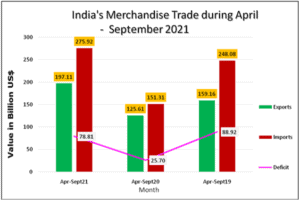
d) Growth in the Digital Economy
The JAM trinity (30 cr Jan Dhan a/cs, 1 Billion + Aadhaar A/c & 1 Billion + Mobile Connections) has brought unexpected benefits not only of enabling millions but also stopping leakages in welfare schemes and truly connecting India. With the cheapest mobile and data services, digital connectivity has provided untold benefits and reduced transaction costs. The benefits were visible in the speed and accuracy of the vaccination process when India recently crossed the 1Bn vaccination mark.
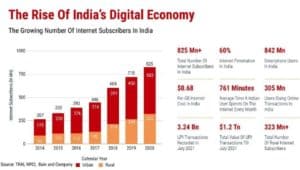
e) The Start-up Ecosystem
The current value of the start-up ecosystem is estimated to be around $ 300 Billion or 10% of the GDP and is estimated to move up to $500 Bn by 2025. India has produced more than 40 Unicorns in the current year itself and the start-ups have raised close to $50 Bn. This is serious money and we are talking world scale. This not only helps in bringing in the much-needed scarce risk capital but also has a large multiplier effect as it is mainly used to ‘burn money’ i.e. pay salaries, IT spends, travel, marketing etc. It is not only helping foster innovation and risk but also creating thousands of new millionaires as ESOPs are encashed.
f) Government Reforms
It is rightly said, “in the midst of every crisis, lies great opportunity”. The Government followed the dictum of, ‘Never waste a crisis and brought in significant reforms during Covid. According to IMF, relevant reforms made by the government and opportunities harnessed, have helped India move up significantly in the World Bank’s Ease of Doing Business index. While steps such as the Goods and Services Tax (GST), Demonetisation, the RERA, and IBC have not yielded immediate positive effects, they have helped to cleanse the system, particularly in banking. The government has initiated key structural changes in the policy and regulatory regime for improving the investment climate and boosting economic growth.
g) Democracy and Demography
India’s working-age population outnumbers its dependent population, and demographers predict that this will continue until 2055. A healthy democracy and the prevalence of the rule of law are a major plus for attracting FDI and boosting investment.
h) Change in mindset and Business Sentiment
Wealth creation is no longer taboo, Risk is no longer a four-letter word, Govt is uttering, ‘Govt has no business to be in Business,’ ‘Tax terrorism’ is easing, Ease of doing business is actually happening and we are suddenly talking world scale and are in the forefront of new technology and the sectors of the future. The Biz sentiment as measured by NCAER Business Confidence Index jumped 14% over the pre-pandemic period and hit a 2 year high in Q2 2021-22 Qtr showing improvement on all four parameters it is based on.
All cylinders are currently firing which shall lead to sustained economic growth for the next 10 years. We are on the cusp of a ‘Chronological lottery;’ tremendous wealth is going to be created in the next couple of decades as India moves to a $10 Trillion economy and beyond. It is up to us to position ourselves and reap the benefits.

Very thought provoking analyses and projections …Sandeep ji I am sure people like you will be majorly instrumental in achieving 10 trillion economy.. Diwakar Sahoonja.
This is going to happen very fast not only because of the present govt’s progressive policy measures but because of the people of modern India who started thinking out of the boxes.